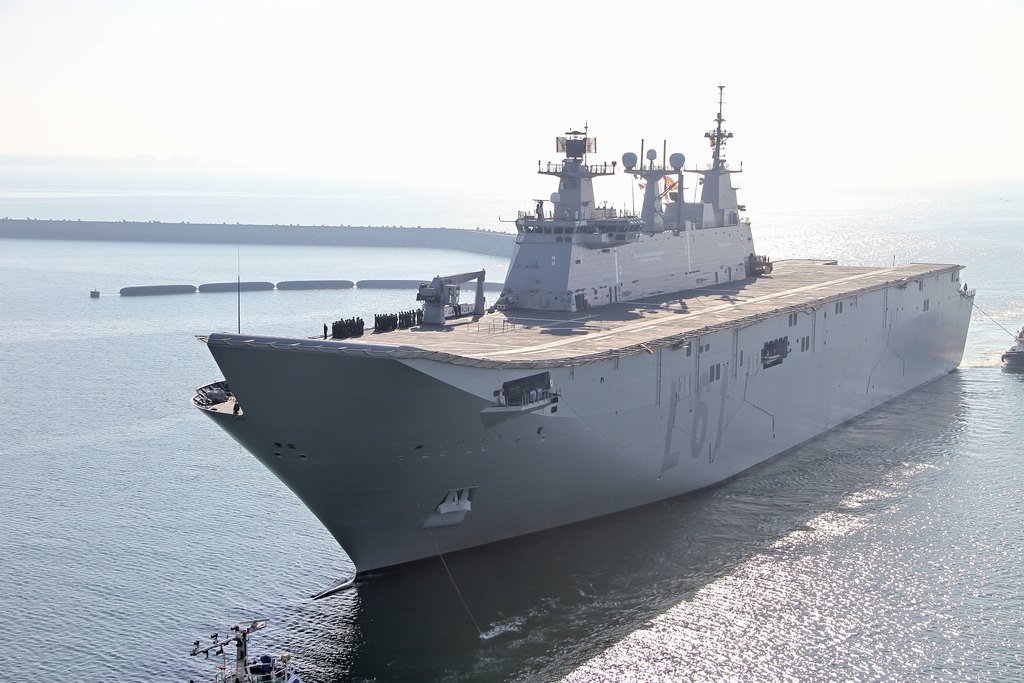Pretty soon, the Royal Australian Navy will take possession of HMAS Canberra, a 27,000-ton-displacement, flat-deck amphibious assault ship.
The RAN plans to use Canberra and her sister HMAS Adelaide to manage crises across the South Pacific. But could the Canberras also give Australia an offensive naval air capability that it has lacked since the early 1980s?
Could the assault ships, in other words, also be aircraft carriers?
In the early 2000s, Australia and a dozen other countries identified amphibious operations as a significant military shortcoming … and set out to acquire large assault ships to fill the gap.
Australia acquired the license to build two vessels based on Spain’s Juan Carlos, capable of launching both helicopters and landing craft. The Canberras should boost the Australian military’s ability to storm a beach … or help out after a natural disaster.
But they’re also, able to carry jet fighters. While officially an amphibious assault ship, Juan Carlos I also operates up to eight AV-8B Harrier jump jets.
Flying Harriers from the assault ship fulfilled Spain’s interest in maintaining naval light-attack and air-defense capabilities, which it had enjoyed since first acquiring the jump jet in 1987. Looking to the future, Juan Carlos I could also carry F-35B Joint Strike Fighters—if the financially troubled Madrid government ever commits to purchasing the pricey stealth jets.
The Australians don’t have Harriers, nor are they planning to acquire F-35Bs. All the same, they retained the Spanish deck layout for the Canberras—a configuration that makes the Australian ships compatible with fixed-wing fighters, should Australia ever acquire them.
Indeed, a 2004 parliamentary report on Australia’s maritime strategy explicitly argued for the government to buy a few F-35Bs along with the 100 or so land-based F-35As Australia already planned to acquire.
To be clear, effectively operating the high-tech JSF takes more than just a flat deck. The Canberras are amphibious warships first. They can support helicopters just fine, but they lack the munitions and aviation fuel storage to support intensive fixed-wing flight operations.
Training, deck organization and personnel for helicopters differ significantly compared to those for fighters. Moreover, flying JSFs from the Canberras would impair the vessels’ ability to carry out their primary mission by taking up deck space and storage and splitting training time.
So turning the Canberras into carriers is tough. But it’s possible. Flat-deck amphibs are flexible ships. In the 2011 Libya conflict, for example, British and French amphibs launched attack helicopters to strike enemy ground forces ashore—a mission no one envisioned just a few years ago.
There’s no question that the Canberras could launch and recover F-35Bs for short missions.
JSFs would also boost the RAN’s ability to carry out air strikes in lightly-defended airspace, although that would mean risking very expensive aircraft for modest effect on the ground.
Perhaps most importantly, Australian F-35s could plug into coalition operations alongside the U.S. and British navies, both of which are also acquiring F-35s for their full-size, purpose-built supercarriers.
If Australia were to commit to a limited carrier strike capacity in the form of modified amphibs and F-35Bs, it certainly wouldn’t be alone. The U.S. Marine Corps will soon operate JSF jump jets from the Navy’s assault ships. Italy, too, plans to purchase F-35Bs in addition to F-35As … and to deploy the vertical-takeoff fighters from the light carrier Cavour.
Japan and South Korea are getting new flat-deck assault ships. Neither government has formally expressed any interest in putting JSFs on the vessels. But as Russia, India and China both already have flattops and fixed-wing naval fighters—and want to build more—Tokyo and Seoul’s calculations could change.
Does Australia need flattops now? No. But the Canberras may serve in the Australian navy for 30 years or longer. It makes a lot of sense to at least preserve the option of converting them for fixed-wing ops. Time may come when Australia needs to defend its ships from air attack, bomb targets ashore or contribute to a wider coalition operation.
And it’s useful to think beyond the F-35B. It might not be long before ship-launched drones can perform many of the same missions as the manned JSF—and more easily. The Canberras might even make better drone-carriers than JSF-carriers.
Not every navy needs a supercarrier to deploy adequate naval air power. For Australia, the Canberras just might suffice.
medium

No comments:
Post a Comment